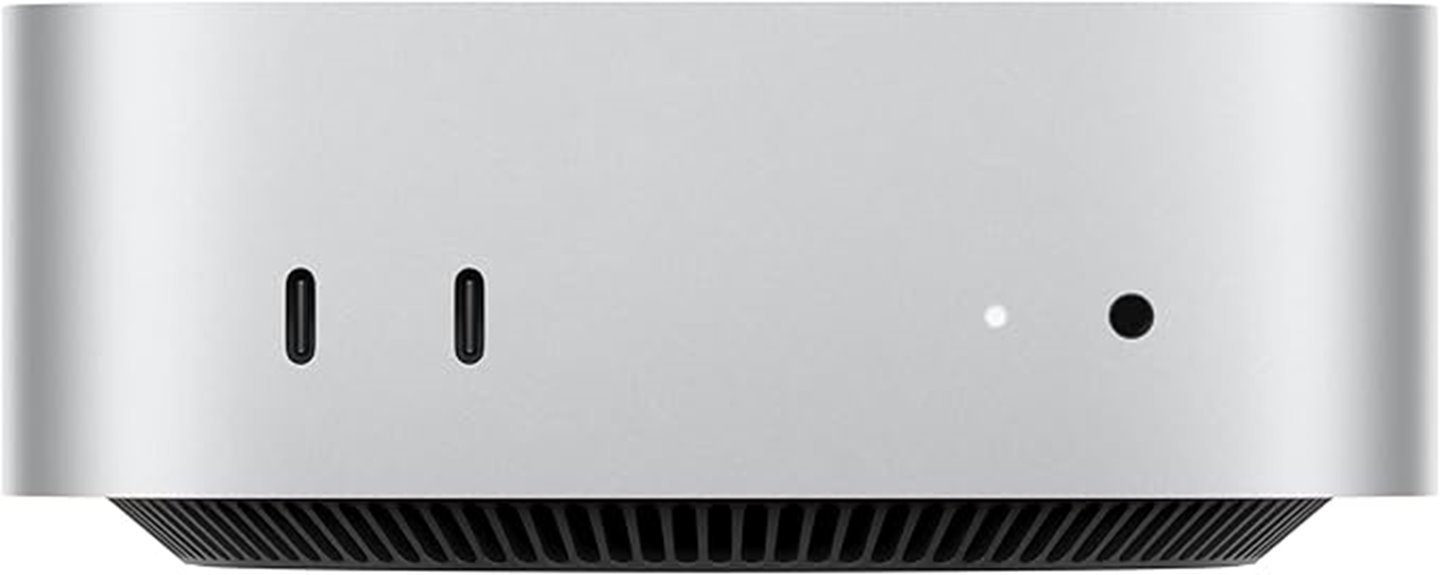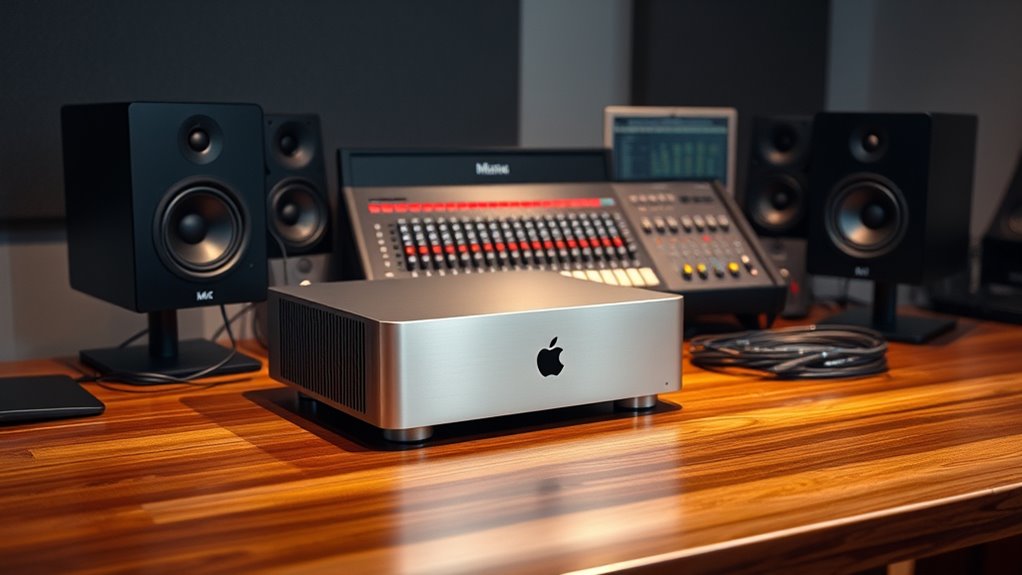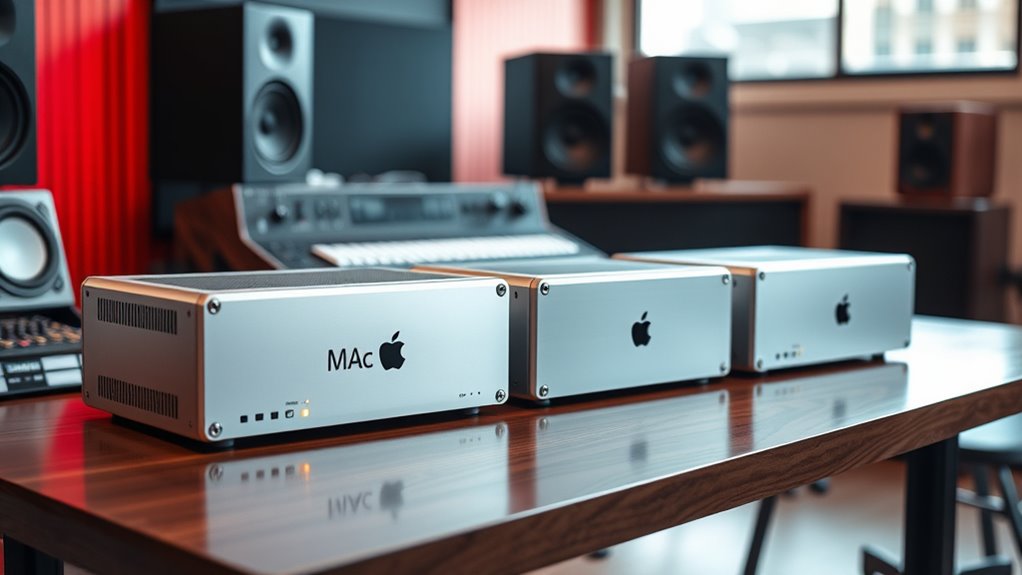If you’re looking for the best Mac Studio models for audio production in 2025, I recommend considering the latest M4 and M4 Pro configurations. The M4 offers excellent power with a 10-core CPU and 16-core GPU, while the M4 Pro provides even more processing with up to 12 cores and 64GB of RAM. Both deliver fast performance, expandability, and quiet operation. Stay tuned—there’s more to explore to help you choose the perfect setup.
Key Takeaways
- M4 Pro models with 12-core CPU and up to 64GB RAM deliver top-tier processing for complex audio projects.
- High-bandwidth Thunderbolt 5 and multiple USB-C ports ensure seamless hardware integration and expandability.
- Configurable SSD options up to 8TB provide ample fast storage for large audio files and samples.
- Support for multiple high-resolution displays and advanced connectivity optimizes multi-monitor editing setups.
- macOS optimization and hardware acceleration on Apple Silicon ensure smooth, reliable performance for demanding audio workflows.
Apple 2024 Mac mini Desktop Computer with M4 Chip

If you’re looking for a compact yet powerful desktop for audio production, the Apple 2024 Mac mini with M4 chip is an excellent choice. Its sleek, five-by-five-inch design and lightweight build make it easy to place anywhere, whether on a desk or next to your monitors. Despite its small size, it delivers impressive performance with a 10-core CPU, 10-core GPU, and 16-core Neural Engine. With up to 32GB of unified memory and fast SSD options, it handles demanding audio tasks smoothly. Its quiet operation and extensive connectivity—including Thunderbolt 4, HDMI, and Ethernet—make it a versatile, space-saving option for professional audio work.
Best For: creative professionals and audio producers seeking a compact, high-performance desktop with excellent connectivity and power efficiency.
Pros:
- Compact and lightweight design easily fits into any workspace or studio setup
- Powerful M4 chip with 10-core CPU and GPU supports demanding audio production tasks
- Quiet operation with efficient cooling maintains a distraction-free environment
Cons:
- Limited internal storage options; 256GB may fill quickly, requiring external drives
- No user-upgradable RAM or storage, so higher configurations are needed upfront
- Port placement on the back may require adjustments for easy access during setup
Apple 2024 Mac mini Desktop Computer with M4 Chip

The Apple 2024 Mac mini with the M4 chip stands out as an excellent choice for audio producers who need powerful performance in a compact design. Its 10-core CPU and GPU deliver fast, smooth processing, ideal for handling demanding audio tasks and multitasking. With 16GB of unified memory and 512GB SSD, it guarantees quick access to files and responsive workflow. Its small footprint allows flexible placement next to monitors or in tight spaces. Equipped with multiple Thunderbolt ports, HDMI, and Gigabit Ethernet, it offers versatile connectivity. Seamlessly integrated into the Apple ecosystem, this mini powerhouse supports high-quality audio and video outputs, making it perfect for professional audio production.
Best For: audio producers and creative professionals seeking a compact, high-performance desktop with powerful processing, versatile connectivity, and seamless Apple ecosystem integration.
Pros:
- Compact size fits easily in tight spaces or next to monitors
- Fast 10-core CPU and GPU ensure smooth multitasking and demanding audio tasks
- Multiple ports including Thunderbolt 4, HDMI, and Gigabit Ethernet offer versatile connectivity
Cons:
- Limited upgradability with fixed RAM and SSD configurations
- May be more expensive compared to similarly specced non-Apple mini PCs
- Only supports up to three displays, which could be limiting for some multi-monitor setups
Apple 2024 Mac mini Desktop Computer with M4 Chip

For audio producers seeking a compact yet powerful desktop, the Apple 2024 Mac mini with the M4 chip stands out as an ideal choice. Its small 5×5-inch design fits easily next to any monitor, while packing a 10-core CPU and GPU, hardware-accelerated ray tracing, and a 16-core Neural Engine. With up to 24GB of unified memory and fast SSD options, it handles demanding projects effortlessly. Connectivity includes Thunderbolt 4, HDMI, and USB-C ports, supporting multiple displays and devices. Despite its tiny footprint, it delivers impressive performance, making it perfect for studio setups where space and power are both priorities.
Best For: audio producers and creative professionals seeking a compact yet powerful desktop with high-performance hardware and multi-display support.
Pros:
- Small, space-saving design fits easily next to any monitor
- Powerful M4 chip with 10-core CPU and GPU, hardware-accelerated ray tracing
- Supports multiple high-resolution displays and fast connectivity options
Cons:
- Limited upgradability beyond initial storage configuration
- No dedicated graphics card options (integrated GPU only)
- Higher cost compared to some other compact desktop solutions
Apple 2024 Mac mini Desktop Computer with M4 Pro chip

The Apple 2024 Mac mini with M4 Pro chip stands out as an ideal choice for audio producers seeking powerful performance in a compact form. Its small footprint, just five by five inches, fits easily on any desk and runs quietly, making it perfect for space-saving setups. Equipped with a 12-core CPU (upgradeable to 14 cores), a 16-core GPU (upgradable to 20 cores), and up to 64GB of memory, it handles demanding audio projects effortlessly. Its versatile connectivity—including Thunderbolt 5, HDMI 2.1, and fast Ethernet—ensures seamless integration with external gear. All this, combined with the sleek design and energy efficiency, makes it a top contender for professional audio work.
Best For: professional audio producers and musicians seeking a compact, high-performance computer for demanding audio projects.
Pros:
- Compact size fits easily on any desk, ideal for space-saving setups
- Powerful M4 Pro chip with up to 64GB RAM handles demanding audio tasks effortlessly
- Versatile connectivity options including Thunderbolt 5, HDMI 2.1, and fast Ethernet for seamless gear integration
Cons:
- Limited internal storage; external SSD recommended for larger projects
- Upgrading CPU and GPU requires technical knowledge and may involve additional cost
- Small physical size may limit future expansion options or hardware upgrades
Factors to Consider When Choosing a Mac Studio for Audio Production

When selecting a Mac Studio for audio production, I focus on processing power to handle demanding projects, ensuring smooth performance. Compatibility with my audio hardware and software is also key, so I check connectivity options and optimization. Finally, I consider storage, memory, and how well the machine meets my connectivity needs to keep my workflow seamless.
Processing Power Needs
Since audio production involves running multiple tracks, effects, and virtual instruments simultaneously, having a powerful processor is indispensable. A fast CPU with multiple cores reduces rendering times and improves real-time playback during complex editing tasks. Adequate processing capacity is vital for running resource-intensive software without latency or dropouts, ensuring a smooth workflow. Higher processing power allows for seamless editing, mixing, and mastering of large projects with high sample rates and bit depths. Investing in a Mac Studio with robust processing capabilities not only enhances current productivity but also future-proofs your setup as your audio projects grow more demanding. Ultimately, choosing a system with sufficient processing power is key to maintaining efficiency and ensuring flawless audio production in 2025.
Audio Hardware Compatibility
Choosing the right Mac Studio for audio production requires careful attention to hardware compatibility; ensuring your setup can seamlessly connect and communicate with your audio equipment is essential for a smooth workflow. First, check that the Mac Studio has enough Thunderbolt 4 and USB-C ports for your audio interfaces, digital mixers, and DSP units. Compatibility with macOS-supported hardware like audio interfaces, MIDI controllers, and studio monitors is critical. Also, verify that the hardware’s processing power can handle high-resolution plugins and real-time effects without latency issues. High-bandwidth data transfer and support for advanced audio formats are indispensable for multichannel recording and playback. Finally, confirm that your audio hardware has the necessary drivers and firmware updates to guarantee seamless operation with the Mac Studio, avoiding potential compatibility hiccups.
Storage and Memory Options
Selecting the right storage and memory options can considerably impact your audio production workflow. Larger RAM, like 32GB or 64GB, allows me to multitask smoothly and handle large projects without hiccups. Storage choices from 512GB to 8TB determine how much high-resolution audio, samples, and projects I can store locally. Faster SSDs with higher capacities mean quicker access to files and shorter load times, boosting efficiency. With the M4 Pro chip’s memory bandwidth up to 200GB/s, I can playback and edit multiple tracks simultaneously without lag. Upgrading to higher storage and RAM not only improves current performance but also future-proofs my setup for more complex, demanding projects down the line. These options ensure my Mac Studio remains a reliable powerhouse for audio production.
Connectivity Requirements
To guarantee my audio production setup runs smoothly, I need to pay close attention to the connectivity options on my Mac Studio. I look for plenty of Thunderbolt 4 or USB-C ports to connect multiple audio interfaces, MIDI controllers, and external storage without hassle. Supporting high-bandwidth connections, like Thunderbolt 4 or USB 3.2, is vital for handling large audio files and real-time data transfer with zero latency. I also verify compatibility with professional audio peripherals, ensuring they work seamlessly with the device’s connection standards and power delivery. If I connect external monitors for editing and mixing, I consider HDMI or DisplayPort options. Finally, reliable Ethernet ports or strong Wi-Fi are essential for online collaboration, cloud storage, and keeping my software up to date.
Software Optimization
Since software optimization directly impacts how smoothly my audio production applications run, I prioritize finding a Mac Studio that leverages the latest macOS updates and is compatible with professional DAWs and plugins. Optimized software ensures my workflow remains efficient by reducing latency and processing delays, even with large, complex projects. Apple Silicon architecture plays a key role here, as software specifically tailored for it can harness hardware-accelerated features like neural engines and media engines, speeding up rendering, mixing, and real-time audio processing. Regular updates from Apple and third-party developers are essential, as they enhance stability, performance, and security. When choosing a Mac Studio, I look for those with proven software optimization, ensuring my setup remains reliable and capable of handling demanding audio production tasks seamlessly.
Future Expansion Potential
When choosing a Mac Studio for audio production, it’s fundamental to take into account its expansion potential to keep up with evolving technology and project demands. I look at the number and types of ports—Thunderbolt 4, HDMI, USB-C—to connect audio interfaces, external drives, and peripherals seamlessly. I also consider internal hardware upgrade options like RAM and storage, which are indispensable for handling larger files and complex projects. Supporting multiple high-resolution displays and high-fidelity audio outputs is critical for multi-monitor editing and precise monitoring. Compatibility with future hardware standards and software updates ensures longevity. Additionally, I check for expansion slots or docks that allow adding PCIe cards or external modules, future-proofing my setup and ensuring it grows with my needs.
Frequently Asked Questions
How Does Mac Studio Compare to Other Audio Production Workstations?
I find the Mac Studio to be exceptional compared to other audio workstations. Its powerful M3 chip delivers lightning-fast processing, making multitasking smooth and efficient. The build quality and optimized software give me a seamless experience, especially with demanding audio projects. While it may be pricier, the stability and performance it offers often outweigh the cost. Overall, I believe it’s a top-tier choice for professional audio production.
Which Mac Studio Model Offers the Best Upgrade Options?
They say, “The best is yet to come,” and that’s true for the Mac Studio. I believe the latest M2 Ultra model offers the best upgrade options, thanks to its powerful hardware and flexible configurations. It allows me to customize RAM, storage, and connectivity to suit my needs. If you’re looking for future-proofing and expandability, this model is the smartest choice for audio production.
Can Mac Studio Handle Real-Time Audio Processing Efficiently?
Yes, the Mac Studio handles real-time audio processing effectively. I’ve used it with demanding plugins and large sessions, and it performs smoothly without lag. Its powerful CPU and ample RAM ensure quick processing, while the robust GPU aids in real-time effects. If you’re serious about audio production, I’d definitely recommend it, as it’s built to handle intense workflows with ease and precision.
What Accessories Enhance Audio Production on Mac Studio?
To enhance my audio production on Mac Studio, I use a high-quality audio interface like Universal Audio Apollo, a professional MIDI controller such as the Akai MPK, and studio monitors like the Yamaha HS series. I also add a reliable external hard drive for storage and a good pair of headphones like the Beyerdynamic DT 770 for mixing. These accessories make my workflow smoother, clearer, and more accurate.
How Future-Proof Is Mac Studio for Upcoming Audio Software?
I believe the Mac Studio is quite future-proof for upcoming audio software. Its powerful M1 Ultra chip and ample RAM mean it can handle new updates and demanding plugins with ease. I’ve found that Apple’s consistent software support and hardware upgrades make it a reliable choice for staying ahead in audio production. So, I’d say investing now guarantees smooth performance for years to come.
Conclusion
Choosing the right Mac Studio depends on balancing power and budget. Think of it like building a house; your foundation must support your needs. Just as a sturdy base ensures a tall building’s stability, selecting a model with the right specs guarantees smooth audio production. Whether you opt for the M4 or M4 Pro, remember that investing in the right hardware is like planting a seed—trust it to cultivate your creative projects effortlessly.









